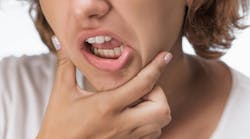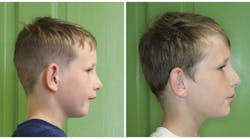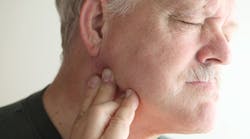Dental hygiene and orofacial myofunctional therapy: Intersections and connections
In October, the ADHA reiterated its support of our profession practicing orofacial myofunctional therapy (OMT), and clarified misinformation that’s circulated about dental hygienists providing this therapy.1 You may have learned about orofacial myofunctional disorders (OMDs) in dental hygiene school or CE courses. According to the International Association of Orofacial Myology, “Orofacial myofunctional disorders manifest as unconventional, adaptive patterns arising when normalized patterns within the orofacial complex are lacking.”2
These adaptive patterns of the tongue, lips, and facial muscles can manifest because of physical challenges such as airway restrictions or tongue ties. They can also develop from habits such as prolonged thumb sucking, or even appear for no known reason. These alterations or habitual movements can have myriad detrimental effects, including headaches, vertigo, and sleep disorders.2 Therapy designed to identify and correct these disorders is called OMT.
Who can practice OMT?
Since OMT is not its own profession, there has been some debate about under which licenses it can or should be provided. The ADHA has supported dental hygienists practicing OMT since 2020, provided they’re certified by the International Association of Orofacial Myology (IAOM).3 This credential allows them to be called certified orofacial myologists, using the post-nominal letters COM.
Currently, dentists, medical physicians, registered dental hygienists, dental therapists, oral health therapists, speech language pathologists, physical therapists, and occupational therapists can become COMs.2 It’s important to note that while the ADHA endorses dental hygienists practicing OMT, the association is not a regulating body. Therefore, each practitioner must adhere to their individual state guidelines regarding this matter.
OMT and RDH overlap
So, how does the field of OMT intersect with dental hygiene? Does it make sense that we would provide these therapies parallel to our primary profession? Believe it or not, dental hygienists are in a particularly beneficial position to practice OMT. Our vocation gives us a unique vantage point in the detection of OMDs. Not only are signs of OMDs easily spotted during dental hygiene treatment, but many of these disorders lead to sequelae that can affect the oral health and hygiene of patients.
For example, facial muscle dysfunction and mouth breathing increase the incidence of plaque in patients, and lip ties and malocclusions can make someone more likely to develop periodontal disease.4 Our motivation to address patients’ OMDs stems from our desire to improve their oral and overall health. At what point during a recall appointment might we encounter existing OMDs, or recognize their potential so preventive steps can be taken?
Upon greeting a patient in the waiting room, you may notice that their face is resting in an open mouth posture. When discussing their health history, you may detect a nasal tone in their voice. Either one of these conditions could indicate airway restriction. A lisp when talking, or incidence of tongue thrust when speaking or swallowing, could clue us into OMDs, such as facial muscle dysfunction or malocclusion.4
What will you encounter?
During an extraoral exam on a patient, you may see signs of additional OMDs. Chronically dry and cracked lips or perioral skin conditions could indicate that someone has not mastered a normal swallowing pattern or may never have developed a standard closed mouth posture. Moreover, investigating the cause of these extraoral conditions could uncover the presence of noxious or prolonged habits that need to be addressed.4
During the intraoral exam, you may discover conditions that require intervention before an OMD develops, such as tongue or lip ties or obstructive tonsils. Tongue and lip ties can cause speech misarticulations or temporomandibular joint issues, and large tonsils and adenoids can restrict a patient’s airway, leading to abnormal breathing adaptations.
The discovery of a scalloped tongue during an exam may indicate bruxism or temporomandibular disorders, and a narrow palate could signify deleterious habits or tongue thrust. Also, other changes in jaw structure may be the cause or result of OMDs. For instance, a restricted maxilla could indicate craniofacial dysfunction, and malocclusions might be the result of sleep disorders or abnormal breathing.4
During scaling, polishing, or rinsing, the patient may exhibit an atypical swallowing pattern. This deviation could be a sign of facial muscle dysfunction. It could also be caused by tongue thrust or open mouth posture. Similarly, drooling may be the consequence of an OMD, as could any change in the patient’s salivary flow.4
Even simply speaking with patients about their oral health concerns can help bring hidden OMDs to light. Almost daily, temporomandibular issues come up in the course of conversation. There are numerous conditions this singular problem might signify, including malocclusion, chewing disorders, bruxism, noxious habits, tongue tie, hypotonic masseters, facial muscle dysfunction, and more. All these conditions are classified as OMDs by the Academy of Orofacial Myofunctional Therapy. What better time to address them than immediately after their discovery?4
Why become a COM?
The fields of dental hygiene and orofacial myofunctional therapy intersect in all the above-mentioned circumstances and many more. Although one need not be trained as a myofunctional therapist or orofacial myologist to observe OMDs, this training is required to provide therapy.
Dental hygienists have always had extensive knowledge in face and neck anatomy, and our current categorization as “health care diagnosing or treating practitioners” puts us in the same standard occupational classification as many other types of medical therapists.5 Myofunctional therapy training allows hygienists to identify OMDs and provide the therapy patients need without having to refer them to others.
The ability to provide this service in conjunction with regularly scheduled dental visits is an opportunity for us to significantly benefit our patients, saving them time and money and bringing them back to an optimal level of oral and overall health. This has always been our primary goal as practitioners.
References
1. Haley-Hitz E, Vanguilder L. Orofacial myofunctional therapy letter. American Dental Hygienists Association. October 2, 2024. Accessed November 1, 2024. https://www.adha.org/wp-content/uploads/2024/10/2024-10-02_ADHA_Orofacial_Myofunctinoal_Therapy_Ltr.pdf
2. What are orofacial myofunctional disorders? International Association of Orofacial Myology. 2024. Accessed November 1, 2024. https://iaom.com/faq/
3. American Dental Hygienists Association. Delegates Manual. 2019-2020. Accessed November 1, 2024. https://mymembership.adha.org/images/pdf/2020_Delegates_Manual.pdf
4. What are OMDs: orofacial myofunctional disorders. Academy of Orofacial Myofunctional Therapy. Accessed November 1, 2024. https://aomtinfo.org/orofacial-myofunctional-disorders-omds/
5. United States Office of Management and Budget. Standard Occupational Classification Manual. 2018. Accessed November 1, 2024. https://www.bls.gov/soc/2018/soc_2018_manual.pdf








